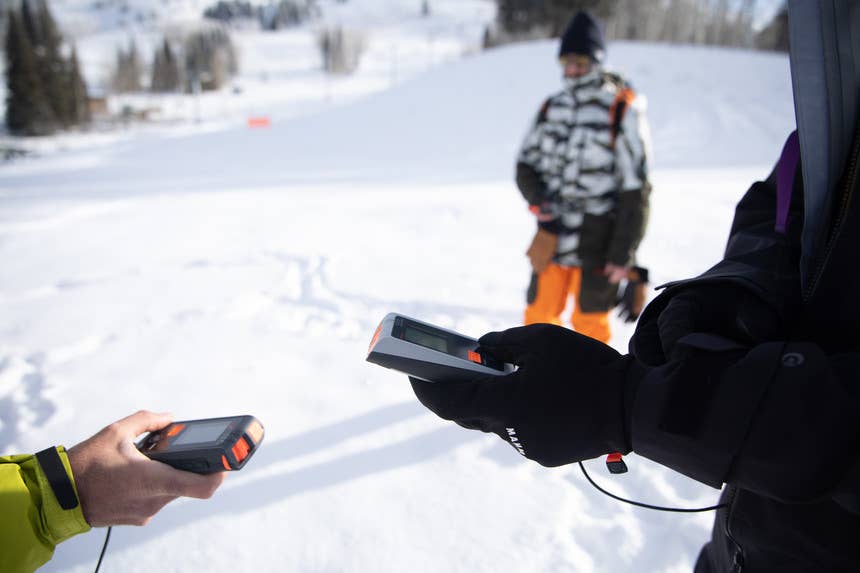

TGR Tested: Mammut Barryvox and Barryvox S Beacons
Popular Stories
 The Barryvox S beacon (left) is a highly-refined lifesaving tool for pros, while the standard Barryvox (right) is an easy-to-use recreationally-focused tool. | Katie Lozancich photo.
The Barryvox S beacon (left) is a highly-refined lifesaving tool for pros, while the standard Barryvox (right) is an easy-to-use recreationally-focused tool. | Katie Lozancich photo.
Avalanche beacons are designed for one thing only: to save lives if you or a buddy get buried in a slide. That being said, they need to be extremely easy to operate, especially in high-stress scenarios where every second counts and you can't waste time figuring out how your equipment works. Mammut has been leading this field for many years, and now offers two very powerful beacon options depending on your use case. For professional users, like ski patrollers and rescue workers, the Barryvox S offers a fully-loaded feature set that are a huge bonus on difficult multiple-burial scenarios. As a second option, Mammut's standard Barryvox beacon offers a few less functions in a less expensive package for the recreational user.
The Barryvox S is both a digital three-antenna beacon and a single antenna analog beacon with up to a 70-meter range, putting it ahead of many beacons on the market. Mammut claims this allows for a 70-meter search strip width during a beacon search. The Smart Search on-screen display of the Barryvox S is somewhat different from other beacons, in that it indicates much more than just a number and a basic direction arrow. In acquisition and coarse search modes, the on-screen prompts show an animation demonstrating what you should be doing (eg. moving fast in a zig-zag across the debris field in acquisition mode, and then slowing down and paying attention to the arrows in coarse mode). Once in the fine search portion of a beacon search, a line and arrow will guide you in performing the cross-bracket pattern in the most efficient manner.
Simplicity and ease of use are paramount when it comes to avalanche rescue, and that’s what the simpler Barryvox is all about. It’s got the same large, easy-to-read display, a flag button and a simple locking switch (that cannot be accidentally bumped, trust us, we tried) to change modes from OFF to SEND to SEARCH. The display shows distance and direction to the strongest signal and the number of buried subjects in the case of a multiple-victim scenario. While Mammut claims the same 70-meter range, during TGR’s International Pro Rider workshop, our instructors did note that it still makes sense to run a smaller search strip while using this beacon, closer to 50 meters, just to be sure you don’t miss a spot. Doug Workman explains that the 70 meter search strip width is based on a "worst case" range of only 35 meters. Three-antenna beacons like the Barryvox have a X, Y, and Z axis antenna, where one is less powerful than the other two. "Worst case" is defined as when the searching beacon's weakest antenna picks up the signal (couples) with the transmitting beacon's weakest antenna. Search strip width is always double the worst case range, and Mammut has determined the Barryvox's worst case range is 35 meters. This allows for a wider search strip during signal acquisition, thus expediting the rescue process.
 Caite Zeliff practicing a beacon search with the Barryvox S during TGR's IPRW 2021. | Katie Lozancich photo.
Caite Zeliff practicing a beacon search with the Barryvox S during TGR's IPRW 2021. | Katie Lozancich photo.
In most of our practice beacon searches at IPRW 2021, the Barryvox S eliminated the need to do all four sides of the bracket and confirmed the lowest number, where we would begin probing. Understanding how these indicators work and what they mean is paramount to using the beacon in real life, but once you figure out the difference, they will help you perform faster and more efficient searches.
Like any other beacon, both the Barryvox S and the Barryvox use a marking function to mask a single signal in a multiple-burial scenario. This allows the searcher to ignore the signal of the first beacon found to continue the search for additional victims. The multiple burial mode also stands apart from the rest, in that it quickly locks into the strongest signal first and selects it. Essentially the beacon makes a decision for you and points directly towards the strongest (usually closest) signal. The on-screen prompts will indicate the total number of signals found and the user can toggle between signals using the selection buttons on the side of the device.
Another unique feature is that the beacon will transmit what Mammut calls “vitals” on a separate W-Link frequency. This tech has been around since Mammut's older Pulse beacons. If you are buried wearing your Barryvox S, the beacon’s built-in accelerometer can communicate the fact that you are moving or breathing to any searcher also using a W-Link enabled beacon. It’s a nice added feature, but brings up the ethical question of “do you trust a machine to decide who to dig out first?” We’ll leave that decision up to you, but statistically it should help save lives.
Sign Up for the TGR Gravity Check Newsletter Now
 TGR guide Doug Workman demonstrating the different pro-mode options of the Barryvox S. Katie Lozancich photo.
TGR guide Doug Workman demonstrating the different pro-mode options of the Barryvox S. Katie Lozancich photo.
In the pro mode on the Barryvox S, switching on the optional analog tone can act to help advanced searchers determine the number of victims buried in close proximity. While certainly not new technology, it allows pros to effectively us an alternate search strategy like the micro strip or 3-circle method to cope with signal overlap (eg. what would happen when two buried beacons signals are timed in unison, confusing the searching beacon). The pro mode allows the user to switch into alternate search modes, toggle between buried signals, and switch on the analog.
The bottom line with both the Barryvox and the Barryvox S is that the standard mode makes for extremely fast single and multiple burial searches even for users with little to no experience. On top of that, the S's pro mode unlocks a feature set that enables avalanche professionals to operate efficiently in difficult situations.



